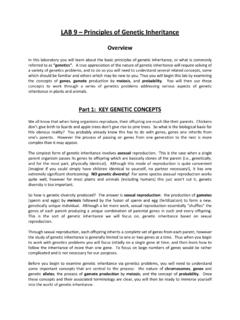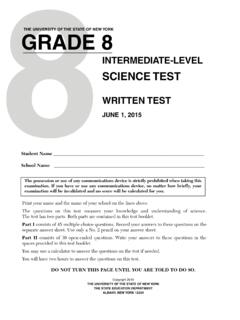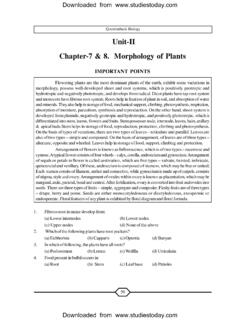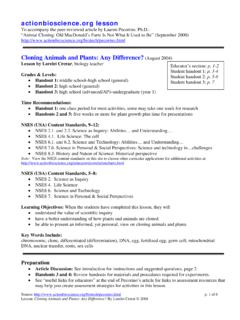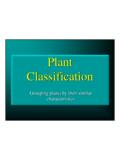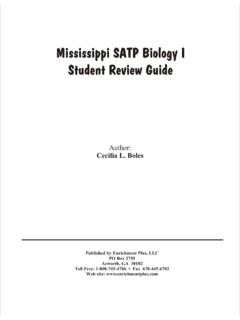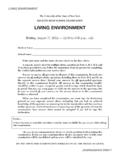Transcription of Core Courses Semester-I BOTANY ( Hons )
1 core Courses Semester-I BOTANY ( hons ). core course BOT. CC I : Microbiology and Phycology- 100 marks (Credits-6: Theory-4, Practical-2). THEORY (Each class 1 hour): PRACTICAL (Each class 2 hours). [75 marks (Mid Sem 15 + End Sem 60)]. Lectures: 60 [40 Theory + 20 Practical classes]. Unit-I Introduction to microbial world, microbial nutrition, growth and metabolism. 2 lectures Viruses:-Discovery ,physiochemical and biological characteristics; 5 lectures classification (Baltimore), general structure with special reference to viroids and prions; replication (general account), DNA virus (T-phage), lytic and lysogenic cycle; RNA virus (TMV). Economic importance of viruses with reference to vaccine production, role in research, medicine and diagnostics, as causal organisms of plant diseases. Unit II Bacteria: - Discovery, general characteristics, types-archaebacteria, 5 lectures eubacteria, wall-less forms(mycoplasma and spheroplasts), cell structure, nutritional types, reproduction-vegetative, asexual and recombination (conjugation, transformation and transduction).
2 Economic importance of bacteria with reference to their role in agriculture and industry (fermentation and medicine). Unit-III Algae:- General characteristics; Ecology and distribution; range of thallus 6 lectures organization; Cell structure and components; cell wall, pigment system, reserve food (of only groups represented in the syllabus), flagella; and methods of reproduction, classification; criteria, system of Fritsch, and evolutionary classification of Lee (only upto groups); significant contributions of important phycologists ( Fritsch, Smith, Singh, Desikachary, Kumar, Iyengar). Role of algae in the environment, agriculture, biotechnology and industry. Unit-IV Cyanophyta:- Ecology and occurrence, range of thallus organization, cell 5 lectures structure, heterocyst, reproduction. economic importance; role in biotechnology.
3 Morphology and life-cycle of Nostoc. Chlorophyta:- General characteristics, occurrence, range of thallus 5 lectures organization, cell structure and reproduction. Morphology and life-cycles of Chlamydomonas, Volvox, Oedogonium, Coleochaete. Evolutionary significance of Prochloron. Unit-V Charophyta:- General characteristics; occurrence, morphology, cell 2 lectures structure and life-cycle of Chara; evolutionary significance. Xanthophyta:- General characteristics; range of thallus organization; 3 lectures Occurrence, morphology and life-cycle of Vaucheria. Phaeophyta:- Characteristics, occurrence, range of thallus organization, cell 3 lectures structure and reproduction. Morphology and life-cycles of Ectocarpus and Fucus. Rhodophyta:- General characteristics, occurrence, range of thallus 4 lectures organization, cell structure and reproduction.
4 Morphology and life-cycle of Polysiphonia. BOT. CC I Practical (20 classes, each class of 2h). Microbiology 1. Electron micrographs/Models of viruses T-Phage and TMV, Line drawings/Photographs of Lytic and Lysogenic Cycle. 2. Types of Bacteria to be observed from temporary/permanent slides/photographs. Electron micrographs of bacteria, binary fission, endospore, conjugation, root Nodule. 3. Gram staining. 4. Endospore staining with malachite green using the (endospores taken from soil bacteria). Phycology Study of vegetative and reproductive structures ofNostoc, Chlamydomona s(electronmicrographs), Volvox, Oedogonium, Coleochaete, Chara, Vaucheria, Ectocarpus,Fucus and Polysiphonia, Procholoron through electron micrographs, temporary preparations and permanent slides. Suggested Readings 1. Lee, (2008). Phycology, Cambridge University Press, Cambridge.
5 4th edition. 2. Prescott, , Harley , Klein D. A. (2005). Microbiology, McGraw Hill, India. 6th edition. 3. Kumar, (1999). Introductory Phycology. Affiliated East-West Press, Delhi. 4. Sahoo, D. (2000). Farming the ocean: seaweeds cultivation and utilization. Aravali International, New Delhi. 5. Campbell, , Reece , Urry , Cain , Wasserman Minorsky , Jackson (2008). Biology, Pearson Benjamin Cummings, USA. 8th edition. 6. Pelczar, (2001) Microbiology, 5th edition, Tata McGraw-Hill Co, New Delhi. Semester-I BOTANY ( hons ). core course BOT. CC II: Biomolecules and Cell Biology . 100 marks (Credits-6: Theory-4, Practical-2). THEORY (Each class 1 hour): PRACTICAL (Each class 2 hours). [75 marks (Mid Sem 15 + End Sem 60)]. Lectures: 60 [40 Theory + 20 Practical classes]. Unit-I Biomolecules:- Types and significance of chemical bonds; Structure and 2 lectures properties of water; pH and buffers.
6 Carbohydrates: Nomenclature and classification; Role of monosaccharides 3 lectures (glucose, fructose, sugar alcohols mannitol and sorbitol); Disaccharides (sucrose, maltose, lactose), Oligosaccharides and polysaccharides (structural-cellulose, hemicelluloses, pectin, chitin, mucilage; storage . starch, insulin). Lipids: Definition and major classes of storage and structural lipids. Storage 2 lectures lipids. Fatty acids structure and functions. Essential fatty acids. Triacyl glycerols structure, functions and properties. Proteins: Structure of amino acids; Peptide bonds; Levels of protein 2 lectures structure-primary, secondary, tertiary and quarternary; Isoelectric point;. Protein denaturation and biological roles of proteins. Nucleic acids: Structure of nitrogenous bases; Structure and function of 4 lectures nucleotides; Types of nucleic acids; Structure of A, B, Z types of DNA.
7 Types of RNA; Structure of tRNA. Unit-II Bioenergenetics: Laws of thermodynamics, concept of free energy, 3 lectures endergonic and exergonic reactions, coupled reactions, redox reactions. ATP: structure, its role as a energy currency molecule. Enzymes: Structure of enzyme: holoenzyme, apoenzyme, cofactors, 4 lectures coenzymes and prosthetic group; Classification of enzymes; Features of active site, substrate specificity, mechanism of action (activation energy, lock and key hypothesis, induced - fit theroy), Michaelis Menten equation, enzyme inhibition and factors affecting enzyme activity. Unit-III The cell: Cell as a unit of structure and function; Characteristics of 2 lectures prokaryotic and eukaryotic cells; Origin of eukaryotic cell (Endosymbiotic theory). Cell wall and plasma membrane: 3 lectures Chemistry, structure and function of Plant Cell Wall.
8 Overview of membrane function; fluid mosaic model; Chemical composition of membranes; Membrane transport Passive, active and facilitated transport, endocytosis and exocytosis. Unit-IV Cell organelles: Nucleus; Structure-nuclear envelope, nuclear pore 3 lectures complex, nuclear lamina, molecular organization of chromatin; nucleolus. Cytoskeleton: Role and structure of microtubules, microfilaments and 2 lectures intermediary filament. Chloroplast, mitochondria and peroxisomes: Structural organization; 2 lectures Function; Semiautonomous nature of mitochondria and chloroplast. Endoplasmic Reticulum, Golgi Apparatus, Lysosomes 2 lectures Unit-V Cell division: Eukaryotic cell cycle, different stages of mitosis and meiosis. 6 lectures Cell cycle, Regulation of cell cycle. BOT. CC II Practical (20 classes, each class of 2h).
9 Practical 1. Qualitative tests for carbohydrates, reducing sugars, non-reducing sugars, lipids and proteins. 2. Study of plant cell structure with the help of epidermal peel mount of Onion/Rhoeo/Crinum. 3. Demonstration of the phenomenon of protoplasmic streaming in Hydrilla leaf. 4. Measurement of cell size by the technique of micrometry. 5. Counting the cells per unit volume with the help of haemocytometer. (Yeast/pollen grains). 6. Study of cell and its organelles with the help of electron micrographs. 7. Study the phenomenon of plasmolysis and deplasmolysis. 8. Study different stages of mitosis and meiosis using aceto carmine and aceto orcine method. Suggested Readings 1. Campbell, MK (2012) Biochemistry, 7th ed., Published by Cengage Learning 2. Campbell, PN and Smith AD (2011) Biochemistry Illustrated, 4th ed.
10 , Published by Churchill Livingstone. 3. Tymoczko JL, Berg JM and Stryer L (2012) Biochemistry: A short course , 2nd ed., 4. Berg JM, Tymoczko JL and Stryer L (2011) Biochemistry, and Company 5. Nelson DL and Cox MM (2008) Lehninger Principles of Biochemistry, 5th Edition., Freeman and Company. 6. Karp, G. (2010). Cell Biology, John Wiley & Sons, 6th edition. 7. Hardin, J., Becker, G., Skliensmith, (2012). Becker's World of the Cell, Pearson Education Inc. 8th edition. 8. Cooper, and Hausman, 2009 The Cell: A Molecular Approach. 5th edition. ASM Press &. Sunderland, Washington, ; Sinauer Associates, MA. th 9. Becker, , Kleinsmith, , Hardin. J. and Bertoni, G. P. 2009 The World of the Cell. 7. edition. Pearson Benjamin Cummings Publishing, San Francisco Semester-I /III (Interdisciplinary): GENERIC ELECTIVE BOT. GE- 1.
